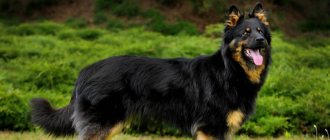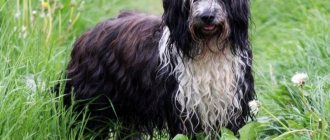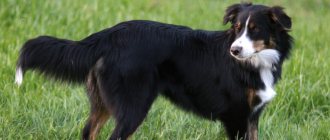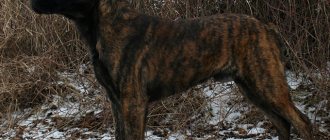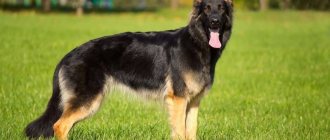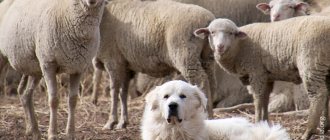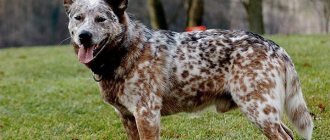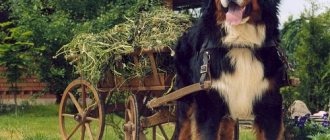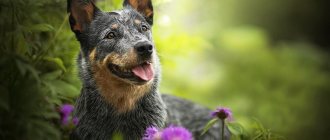| Origin | Netherlands |
| Usage | shepherd and watchdog |
| Color | brindle, pepper and salt, blue-gray |
| Dimensions | 55-62 cm at the withers |
| Lifespan | up to 14 years old |
The Herder or Dutch Shepherd is a rare European breed. Their flexible nature, combined with developed intelligence and training abilities, allows these shepherds to be used as service dogs. An interesting palette distinguishes dogs from related species, but does not allow them to compete in popularity with the beautiful Germans. In its homeland, this breed is actively used, which is why it is often called simply a local shepherd dog, sometimes a Danish or Dutch shepherd dog, as well as a Herder, a Dutch Herder and a Herderhunder.
Brief historical background
According to official data, the history of the breed goes back just over two hundred years. Although, it is possible that dogs similar to Herderhunders appeared in Holland earlier. Their ancestors are considered to be Belgian shepherd dogs (Malinois), who crossed the border between two neighboring states with flocks of sheep and crossed over the centuries with local dogs.
Herderhunder literally means “shepherd”. Dogs were bred by people of the same profession, focusing primarily on working qualities and not paying any attention to exterior characteristics.
Clubs for fans of this breed in the Netherlands began to appear after 1860. For the first time, Dutch herding dogs were presented in 1874 at the Amsterdam exhibition under the simple name “local shepherd dogs”. They received their breed name Hollandse Herdershond in 1878, and on June 12, 1898 (the official birthday of the breed), the national Dutch Shepherd Club was founded, in whose stud book 17 individuals were immediately entered. However, a preliminary standard was not described until 1935.
The Dutch Shepherd standard is considered one of the oldest, and it has only changed twice.
The Dutch Shepherd is considered a national treasure of the Netherlands.
The international canine community recognized the breed in 1960, at which time the standard requirements were refined and changed. In the FCI registry, Dutch Shepherds are listed under number 223 (1st group - “Shepherd and Cattle Dogs”, 1st section - “Shepherd Dogs”) . The current current standard dates back to October 21, 2009.
The first pair of Dutch Shepherds were brought to Russia from the United States in the early 2000s, and the first litter was registered only in 2013.
Mating
Breeding the Dutch Herder must be done carefully, always avoiding accidental mating. It is necessary to choose a partner carefully, even within a breed, since short-haired, long-haired and wire-haired varieties should not be crossed with each other.
Mating of a Danish Shepherd can be carried out when the dog has reached the age of 2 years. Mating always takes place in the male dog's territory.
The pedigree qualities of the male must be equal to or exceed the class of the female.
In order to guarantee pregnancy, mating is carried out again after a day.
Character of the breed
Netherland Shepherds are distinguished by their light, active character, but at the same time they have a balanced and calm temperament . They literally cannot sit still, trying to quickly fulfill the instructions of their adored owner, to whom they are attached with all their hearts. Dogs are able to take initiative and make independent decisions. Alert and sensitive, the Dutch are good watchmen and bodyguards, harmoniously combining fearlessness with intelligence and intelligence.
Lack of attention, prolonged loneliness and lack of close connection with people are difficult for the breed. The pet treats strangers with distrust, is not afraid, but also rarely shows aggression. The dog will never even bark in vain; he only voices when necessary. The Dutch adapt well to various situations and easily get used to any conditions.
Dutch Shepherds always vigilantly guard the territory entrusted to them.
It has been observed that Dutch Shepherds are hostile to strangers only when they try to enter the house. Dogs are completely indifferent to strangers outside the protected area.
Sociable and friendly shepherds can work with several dogs, for example, when herding sheep. They behave peacefully with other pets, keeping them under their protection and constantly trying to gather everyone in one place. Children are treated kindly and tenderly, happily keeping company in all kinds of outdoor games and childish pranks. Patient animals protect and protect babies.
Reviews
Vitaly:
The breed is great for athletes and active people. It’s a pleasure to relax in nature with the “Dutch”; they are happy to accompany the cyclist; they are strong and energetic. An extremely amazing combination of an affectionate dog and a real service dog. There were no problems in upbringing; it was easier than with the “German”.
Dmitriy:
Shepherd to the core. While walking, he tries to gather everyone together into a herd. A formidable and fearless guard, but at the same time loyal, peaceful, obedient and gentle - in a word, amazing.
How to choose a brindle shepherd puppy
Buying a Dutch Shepherd is very difficult, since no more than three hundred puppies are registered in the world every year, and most of them are in their historical homeland. It is recommended to purchase an animal only from trusted nurseries that have a large number of positive reviews and a good reputation. A responsible and conscientious breeder provides the necessary set of documents confirming the puppy’s pedigree (parents’ pedigrees, puppy statistics, etc.).
Dutch Shepherds are born almost black, only after two months does the characteristic brindle appearance of the breed begin to appear. Even the type of coat cannot be predicted immediately.
average cost
In European nurseries, the cost of purebred Dutch Shepherds varies from 500 to 700 euros. In our country, these dogs can be bought for 35–60 thousand rubles. The specific amount directly depends on the title of the parents, pedigree, color and type of coat.
It is impossible to find a purebred Dutch Shepherd from an advertisement or from someone else. In such cases, they usually offer a puppy that is visually very similar. Before purchasing, it is best to seek help from an experienced dog handler who understands the nuances of this particular breed.
Dutch Shepherd puppies are born almost black, then gradually acquire the breed's brindle color.
Health
From hardy ancestors, the Danish Shepherd received excellent health, with a low chance of genetic abnormalities. Health problems rarely appear in this breed before the age of 10, which is quite late for such large dogs. Maintaining the tone of the muscular system through intense physical activity weakens the effect of age on the condition of the animal’s bones and joints.
Dutch Shepherd puppies, who receive high-quality, nutritious nutrition from a very young age, are distinguished by strong natural immunity. Regular visits to the veterinarian, timely vaccinations and constant prevention of parasitic infestation will help maintain your pet's natural health.
Diseases
The heredity of the herding dog breed does not imply a large number of congenital problems. There is a possibility of the following genetic pathologies:
- epilepsy;
- joint dysplasia;
- cataract;
- tympanitis.
In old age, a Dutch Herder has an increased risk of:
- heart disease;
- joint damage, usually due to improper physical activity;
- oncology;
- inflammation of the reproductive system in females.
In case of prolonged or frequent hypothermia, the short-haired Danish Shepherd can get respiratory diseases. Drafts should also be excluded, especially if the dog is wet.
Vaccinations
The Dutch Herder requires the same measures to prevent dangerous diseases as other dogs. Vaccination against diseases such as:
- viral hepatitis;
- rabies;
- carnivore plague;
- parainfluenza;
- coronavirus;
- trichophytosis;
- paravirus;
- leptospirosis.
Herder puppies are vaccinated for the first time after 7 weeks, and then at 12 weeks of age. Next, the Dutch Shepherd is vaccinated annually according to a schedule drawn up by a veterinarian. Animals that are sick, weak or infected with parasites should not be vaccinated. Puppies from each procedure are quarantined for 2 weeks.
Keeping a Dutch (Dutch) Shepherd
The Sheepdog, being a peasant shepherd dog, needs space and freedom of movement. She will feel most comfortable in a country or private house, where she can walk and run in a large courtyard or enclosure (you need to equip an insulated booth there).
Netherland Shepherds cannot be chained or locked up.
Representatives of the breed are able to adapt to cramped living conditions, but can sometimes be destructive due to excessive activity and mobility.
Features of character and behavior
Dutch Shepherds are very active, balanced animals with a strong territorial instinct. Communication skills are not very developed.
Advantages
- Unlike their German brothers, Herderhunders rarely bark, especially if there is no reason to do so.
- They are not choleric, although they are quite cheerful, active, and love to play.
- Shepherd dogs are balanced, calm, and non-conflict.
- They do not start fights with their brothers, and do not attack without reason.
- They are easy to control at work, they obey commands and obey the authority of their owner. The owner is a leader for them; the Dutch are very attached to him, devoted, and strive to receive praise.
- Herders get along well with other animals. They will be especially pleased with the presence of chickens, piglets, sheep, that is, animals that can be grazed. They will do this with gusto all day, feeling their importance.
- Dogs get along with children, especially active ones; except for the smallest ones, they usually ignore them and do not show aggression.
- Like other shepherd dogs, Herders are good guard dogs. They carefully monitor the situation around them, read the plans of strangers, and good hearing and vision only help in this.
- Although dogs are not inclined to attack without reason, if necessary, they bark, scaring away the intruder, and can attack when absolutely necessary.
Flaws
One of the main difficulties is not very developed communication skills. The dog is wary of everything new. The owner will have to gain the puppy's trust; he needs to be socialized as early as possible. If the owner manages to establish contact, the dog will obey; if not, the Herder will take the position of leader and ignore commands and attempts to educate.
- Representatives of this breed have a hard time experiencing any changes, moving, new enclosures depress him. It is especially difficult for him to change his owner.
- The dog trusts new people little, does not strive to make contact, and is distrustful. At the same time, the Herder cannot stand loneliness and greatly misses attention.
- Animals of this breed are touchy and vulnerable, do not tolerate rude words and harsh treatment, even from the owner.
- You need to be persistent in training, but without going overboard, otherwise the dog will build an “ice wall” around itself for a long time.
Features of care
There are no difficulties in caring for Dutch Shepherds.
Hygiene
A standard set of hygiene procedures:
- Brush weekly with a strong brush; during active shedding, this should be done daily. Wire-haired varieties should be trimmed once every six months.
- Once every 5-7 days, inspect the ears and eyes, clean with cotton pads with zoo lotion.
- Brush your teeth every 7-10 days using animal paste and a special brush.
- Trim the nails, if they do not grind down on their own, about once a month.
- Bath as little as possible, only when absolutely necessary (no more than once a year).
Walk
Dutch Shepherds must have the opportunity to run and play to their heart's content, otherwise their character will deteriorate. You need to walk these dogs twice a day for 1.5–2 hours, and not just walk, but give the pet the opportunity to play, jump, run and perform various physical exercises (for example, on a dog playground).
The breed is suitable for active and restless owners who can provide their pets with the proper level of physical activity, taking them with them for a morning jog in the park, bike rides, trips out of town, etc.
You need to walk with shepherds a lot and for a long time
Nutrition
When it comes to food, Dutch Shepherds are completely unpretentious. They can be fed with both factory-made freeze-dried food, choosing products of at least super premium class (Pro Plan Adult Large Athletic, Royal Canin HE Club, etc.), and home-made freshly prepared food. Adult dogs are given food twice a day, puppies more often - 3-6 times a day.
The natural diet consists of:
- lean raw meat (horse meat, rabbit, veal, etc.);
- offal and meat trimmings;
- cereals (rice, buckwheat, etc.);
- eggs;
- fermented milk products with reduced fat content (cottage cheese, fermented baked milk, kefir, etc.);
- unrefined vegetable oils;
- greens, seasonal fruits and vegetables;
- ocean fish (boiled, boneless);
- vitamin and mineral complexes.
It is forbidden to feed shepherds fatty, sweet, smoked, fried, as well as citrus fruits, legumes and tubular bones.
Description of the appearance of Herder dogs
The Herder is a medium-sized dog, height at the withers is from 55 to 62 cm. The physique is graceful, dry, the bones are strong, but not heavy. Therefore, the weight does not exceed 30 kg. Outwardly, it resembles the Belgian Malinois, but is slightly smaller in size and the colors are not as varied, usually brindle. The breed standard was created in the middle of the 20th century and was changed only 2 times.
Head
The head is small, proportional to the body, slightly elongated. Smoothly turns into a long narrow muzzle. The skull is flat, the stop is smooth, almost not pronounced. Jaw with strong muscles and large teeth, correct bite. The lips are dark, thin, and fit tightly. The bridge of the nose is straight, the lobe is large, and should be black.
The eyes are almond-shaped, widely spaced. The iris is dark, the look is smart, cheerful. The ears are medium in size, erect, set high. They are triangular in shape with sharp tips.
Frame
Herder is a dog with a harmonious physique and well-developed muscles. The body is slightly elongated and flexible. The neck is graceful, without dewlap. The chest is deep, narrow, smoothly blending into a slightly tucked underline. The back is straight and short, the croup is sloping.
The tail is quite long, hanging down to the hock joint, the tip slightly curved. In an excited state, the dog lifts it vertically. The tail should not be wrapped in a ring.
Limbs
Limbs are straight, slender, muscular. Placed in parallel. The paws are compact, the long toes are gathered into a ball, the claws are black and strong. Movement is free and easy. Herder runs fast, jumps high, and easily changes direction on the move.
Wool
Based on coat type, the standard distinguishes 3 varieties of Dutch Shepherds.
- Shorthair is the most common. The coat is straight, smooth, and lies tightly. Forms a longer collar, feathering on the legs and tail. The undercoat is dense and dense.
- The wire-haired variety has thick, coarse, tousled hair of medium length. On the muzzle it forms a beard and thick eyebrows. The undercoat is soft and dense.
- Long-haired is the rarest variety, almost never seen now. The coat is straight, not wavy, rough to the touch. The undercoat is dense and dense. There are featherings on the ears, chest and tail.
Color
The color of the coat can be red, brown, golden. Common colors include brindle, salt and pepper, and blue-gray. The color should not be uniform. The Dutch Shepherd has transverse black stripes all over its body. They may not be noticeable in the wire-haired variety. A black mask is desirable on the face of all dogs. There should be no white spots.
Photos complement the description of the appearance of representatives of the breed:
Training and education
Incredibly flexible and attentive, Dutch Shepherds are very easy to train. Dogs learn quickly, grasping everything on the fly and instantly remembering commands.
The puppy needs to be introduced to the rules of behavior and socialized from a very early age, otherwise he may grow up to be fearful and unsociable. When training, it is extremely important to act confidently, consistently and patiently, as independent Shepherds tend to be stubborn. The owner must be a leader and authority for the dog.
Dutch Shepherds are highly trainable and participate in various dog competitions.
When working with Dutch women, cruelty and physical punishment are excluded.
How much do they cost and where to buy
Buying a Herder puppy is not an easy task. It is available exclusively in the Netherlands, Belgium and France. It is almost impossible to find a nursery in Russia. Most likely, the puppies will not meet the stated characteristics and will turn out to be a cross between unknown breeds. The average price for a purebred Herder is $1000-3000. The choice of a puppy should be done under the supervision of a specialist, so as not to regret wasted money.
The Herder is one of the most underrated breeds. He has a quick and clear mind, loves his owner very much and is always ready to be useful. Unfortunately, this species is endangered and can only be preserved by dog enthusiasts.
The best nicknames for representatives of the breed
The unusual, albeit rustic appearance of Dutch Shepherds suggests equally interesting names.
The following nicknames are suitable for boys:
- Dirk;
- Patrick;
- Mayer;
- Johan;
- Gray.
Girls can be called like this:
- Cutie;
- Odette;
- Icy;
- Iris;
- Hel.
Pedigree puppies are given nicknames at the club. For example, when our German Drahthaar dog had puppies, they were all given names starting with the letter “O”. These official nicknames were recorded in the puppy's records, and the new owners called them whatever they wanted.
The best conditions - the best puppies
When choosing a puppy of any breed, you should pay great attention to which kennel its parents belong to. It is no coincidence that the dog kennel “Zhuol” has long earned respect among the “shepherd breeders” of Russia. Therefore, come to us! We are located near Moscow in a beautiful area of the Moscow region. Our dogs have the fortunate opportunity to live in excellent environmental conditions and enjoy long walks in the fresh air. They are constantly monitored by experienced specialists, including not only a veterinarian, but also a livestock specialist and a trainer instructor. With all this, the price of a German Shepherd puppy from our kennel will not be higher than from other breeders. There is a much more “customer-oriented” approach without unnecessary expenses. And don’t forget that puppies from “Zhuol” are a guarantee not only of high exterior qualities, but also of excellent psyche. After all, charming purebred German Shepherd puppies will eventually turn into strong and serious dogs. That is why you need to pay close attention to mental health when choosing a pet. All dogs sold in our kennel have a true “Nordic character”. Screams, sounds of firecrackers and fireworks - all typical “street sounds” do not disturb our students. By contacting our nursery, you can focus solely on your preferences. Indeed, in addition to the usual smooth-haired “Germans” of black color, we also have long-haired varieties of dogs of this breed or representatives of black color. So, if you want to inexpensively buy healthy and beautiful German Shepherd puppies from reliable and reputable manufacturers with delivery throughout Moscow, the Moscow region and other regions of Russia, then we, the team of the Zhuoll breeding kennel, will be glad to meet you. Come, we are waiting!
Key points in training
Dutch Shepherds are capable of mastering OKD and many other commands, working as a tracker, in the rescue service and as a shepherd, although training is sometimes difficult. Dogs are a little stubborn and do not tolerate rough coercion. It is better to carry out training in the form of a game, consolidating successes with treats. It is necessary to achieve mandatory execution of commands.
Read about how to properly train a dog in the article: “Training a puppy: effective methods from dog handlers, learning commands at home.”
Education and training will be successful only if the owner has managed to build a trusting relationship with the pet. Then the herder will be happy to do everything that is required of him and will learn new things with interest.
How to position the ears
It is not always the case that a pet’s ears automatically take on the “upright” position; sometimes the owner has to apply force to achieve this. So, to set up the ears you will need:
- ice cream sticks;
- patch;
- soft curlers.
Before starting the process, you need to prepare the ears, namely treat them with peroxide or alcohol-based lotion, but the liquid should not get inside the ear. Using a patch, you need to attach the stick to the base of the ear, securing the jumper between them.
Jumpers and sticks need to be changed several times a week, especially if they get wet. Using this method, your pet's ears stand up in 3-4 weeks.

